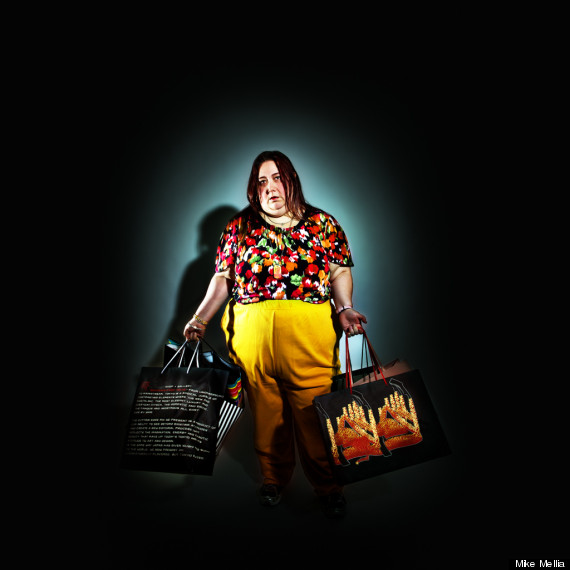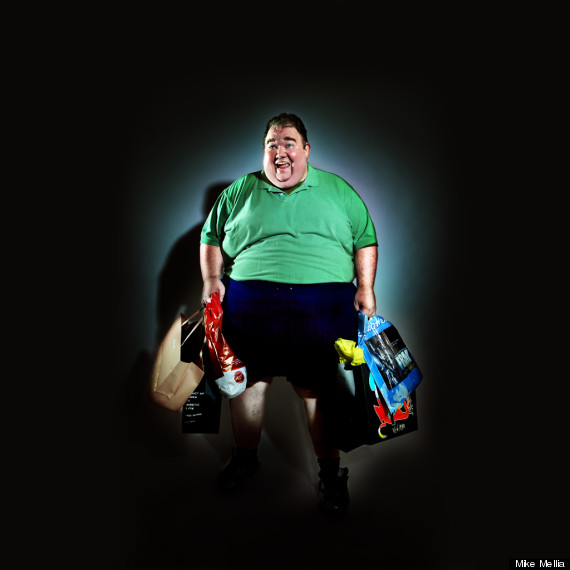The stereotypical view of the American consumer isn't pretty. We tend to like sweatpants, greasy french fries, and waddling over to the next shopping adventure in between meals. Mike Mellia's photographs capture the "can I supersize that?" ethos in vibrant colors that tickle the eye and turn the stomach.
In a way, the photographs are over-the-top in their grotesque portrayal of excess, but then again, we feel as if we've seen these people before, perhaps many times. We thought "American Consumers" was a train wreck we couldn't look away from, so we asked Mellia for more info.

HP: This is a pretty harsh view of the American consumer. Who exactly are you portraying?
MM: The portraits were from my latest gallery exhibition, “Monday Morning: Wall Street & America,” which explored the perceived antagonistic cooperation between Wall Street and Main Street. The show was presented as two sets of portraits, which together comprise a self-contained perpetuating ecosystem. Part I is a day-in-the-life of a finance employee conducting business while simultaneously doing something unintelligent. Part II portrays the archetype of the ideal citizen, whose existence is defined by what he consumes and how much. Both parts require the other for the wheel to continue spinning. In the new American economy of bailouts and regulatory intervention, there is often the perception of an unhealthy co-dependence between Wall Street and Main Street.
HP: Where did you find these models? How did they feel about being projected in such a negative light?
MM: Richard Avedon said, “My portraits are more about me than they are about the people I photograph,” and that certainly holds true in this case. The extremely harsh shadows behind the models, along with the Hitchcock-inspired lighting, create an immense feeling of dread. In the “Portrait of an American Consumer #1-3,” the emotions evolve from a euphoric mania, to confused, to ultimately depressed and desperate.
The models are all professional actors that I hired here in New York City, who fully committed to their characters, and were able to portray genuine emotions on film. All the publicity surrounding the exhibition has helped the actors find additional roles. At the time, I was thinking about how photographers like Diane Arbus and Philippe Halsman always seemed to find a connection with their subjects.

HP: We're curious. Where did you grow up?
MM: I grew up in the Bronx for most of my life, and I now live and work in Manhattan. Back when I was attending Columbia University, visiting museums and jazz clubs every week had the biggest impact on my education at the time.
This is also a very interesting question to me because I think the “Monday Morning: Wall Street & America” exhibition had a very strong New-York-City point of view in some ways.
HP: Where does your work as an advertising photographer place you in relation to these consumers?
MM: Ironically, I think that these portraits could very easily be used as advertisements. To me, the most important element of advertising (or fine art) is emotion, and the image must make enough of an impact to stick in viewers’ minds. Theoretically, with a quick wardrobe change, they could very easily be used in holiday shopping ads for some of the edgier video game companies, anything involving tourists, fitness clubs, online shopping companies, pharmaceuticals, food companies, etc. The same portrait can drastically change its meaning for advertisers when placed in different contexts. It becomes more along the aesthetics of the portraits used in European ads.
The heart of your question, and really of this entire series, is the issue of self-awareness. In this exhibition, although the finance employees and the American consumers in these portraits may share similar character traits, it is unclear if either is aware of their condition.
HP: True or false: if your work isn't offending someone you're playing it too safe.
MM: If you are following your vision with a clear concept, the level of offensiveness is irrelevant. The biggest part of being an artist is having the ability to believe in yourself.

What do you think, readers, is this the American nightmare or just plain offensive? Let us know in the comments section.